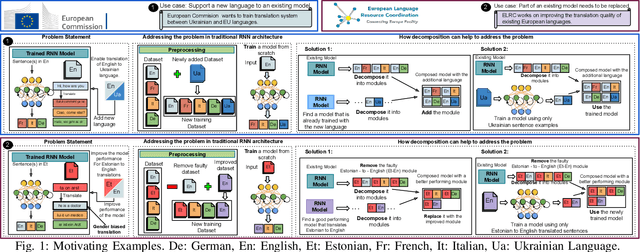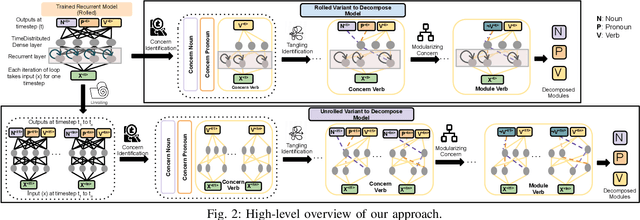Breno Dantas Cruz
Decomposing a Recurrent Neural Network into Modules for Enabling Reusability and Replacement
Dec 15, 2022



Abstract:Can we take a recurrent neural network (RNN) trained to translate between languages and augment it to support a new natural language without retraining the model from scratch? Can we fix the faulty behavior of the RNN by replacing portions associated with the faulty behavior? Recent works on decomposing a fully connected neural network (FCNN) and convolutional neural network (CNN) into modules have shown the value of engineering deep models in this manner, which is standard in traditional SE but foreign for deep learning models. However, prior works focus on the image-based multiclass classification problems and cannot be applied to RNN due to (a) different layer structures, (b) loop structures, (c) different types of input-output architectures, and (d) usage of both nonlinear and logistic activation functions. In this work, we propose the first approach to decompose an RNN into modules. We study different types of RNNs, i.e., Vanilla, LSTM, and GRU. Further, we show how such RNN modules can be reused and replaced in various scenarios. We evaluate our approach against 5 canonical datasets (i.e., Math QA, Brown Corpus, Wiki-toxicity, Clinc OOS, and Tatoeba) and 4 model variants for each dataset. We found that decomposing a trained model has a small cost (Accuracy: -0.6%, BLEU score: +0.10%). Also, the decomposed modules can be reused and replaced without needing to retrain.
DeepDiagnosis: Automatically Diagnosing Faults and Recommending Actionable Fixes in Deep Learning Programs
Dec 07, 2021



Abstract:Deep Neural Networks (DNNs) are used in a wide variety of applications. However, as in any software application, DNN-based apps are afflicted with bugs. Previous work observed that DNN bug fix patterns are different from traditional bug fix patterns. Furthermore, those buggy models are non-trivial to diagnose and fix due to inexplicit errors with several options to fix them. To support developers in locating and fixing bugs, we propose DeepDiagnosis, a novel debugging approach that localizes the faults, reports error symptoms and suggests fixes for DNN programs. In the first phase, our technique monitors a training model, periodically checking for eight types of error conditions. Then, in case of problems, it reports messages containing sufficient information to perform actionable repairs to the model. In the evaluation, we thoroughly examine 444 models -53 real-world from GitHub and Stack Overflow, and 391 curated by AUTOTRAINER. DeepDiagnosis provides superior accuracy when compared to UMLUAT and DeepLocalize. Our technique is faster than AUTOTRAINER for fault localization. The results show that our approach can support additional types of models, while state-of-the-art was only able to handle classification ones. Our technique was able to report bugs that do not manifest as numerical errors during training. Also, it can provide actionable insights for fix whereas DeepLocalize can only report faults that lead to numerical errors during training. DeepDiagnosis manifests the best capabilities of fault detection, bug localization, and symptoms identification when compared to other approaches.
 Add to Chrome
Add to Chrome Add to Firefox
Add to Firefox Add to Edge
Add to Edge